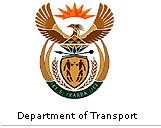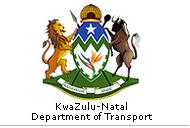 |
Building and Construction MaterialsBuilding and construction materials manufactured in
KwaZulu-Natal include paving, kerbs, decor, tubes, pipes
and fittings, bricks, blocks, etc. The estimate of the
tonnage of different commodities is made difficult by the
wide range of products incorporated in this sector. These
products include tools, gypsum, paint, glass, wood,
particle board, electrical fittings, doors, windows,
structural steel, reinforcing steel, plastics, textiles,
ready-mixed concrete, sand, stone, and building cement and
lime.
The size of the South African construction market in 2004
was estimated at R 100 billion. The main contributors to
total income were construction of buildings with R33.1
billion (33,0%), of civil engineering
structures with R27.4 billion (27,4%), other building
completions with R10.6 billion (10,6%), and other building
installations with R8.9 billion (8,9%).
If investment targets are achieved, this sector could
double in size over the next decade. The estimated
production capacity in South Africa, including its Customs
Union partners, was 13.0-13.5 million tons in 2004.
South Africa's cement and building supplies industries
have geared up for the expected construction boom, with
new projects worth around R4.0 billion announced in 2005
and further projects in 2006-2007.
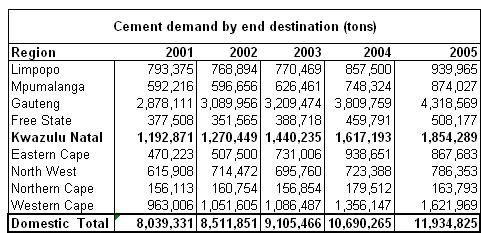
|
CementIn 2005, the demand for cement was estimated at 11,9
million tons of which KwaZulu-Natal was responsible for
1,8 million tons. All South Africa's major cement
producers have begun importing to meet increasing
demand as a result of the wide range of capital projects
scheduled for completion before 2010. These include 5
major new stadiums and 5 stadium upgrades along with other
projects. Cement sales for March 2007 increased to 1,374
million tons from 1,18 million tons for the same period
in 2006. Based on these statistics, it can be estimated
that cement sales for 2007 could be approximately 16
million tons.
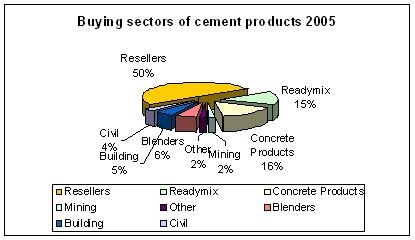
|
The proportion of cement sales by sector is shown in the
above graph for 2005. South Africa’s
4 cement companies together operate 11 cement factories
that have been continuously expanded to meet the local
demand over the last 50 years. The main cement plants in
KwaZulu-Natal are at Durban (Coedmore area) and Newcastle
with current capacity of about 1 million tons per year.
Announcements of capacity expansion totalling 3,3 million
tons p.a. (including refurbished capacity) at the various
factories will raise the total South African industry
capacity to about 16,5 million tons per annum. The demand
forecasts
indicate that this capacity will be sufficient to satisfy
expected growth to the end of 2012. In 2006/2007, the
import of cement and clinker through South African
ports was estimated at 891,012 tons.
The total market share of ready-mixed concrete has grown
from 13,9% to 15,5% in 2005 (based on cement sales),which
is 20% growth for two consecutive years.
There are numbers of manufacturers of precast concrete
products in the province, all of which use only road
transport for their products. StoneAggregate is produced in or near most cities and towns in
South Africa. Crushed stone, sand and gravel are most
often used by the construction industry. Industrial sand
and gravels are used for purposes such as foundry
operations, glass manufacturing, abrasives and filtration
beds of water-treatment facilities, as a source of calcium
in fertilisers, as a metallurgic fluxstone, and as
filtration systems.
Aggregates make up 70% or 80% of the volume of
concrete, and the aggregates used in asphalt mixtures
(roadways – hot-mix asphalt, cold-mix asphalt,
surface treatments) comprise approximately 95% of the mix
mass.
Aggregates include crushed stone, sand and gravel, and are
the most abundant natural resource available. They are
used
as a primary raw material component in construction,
agriculture and other chemical and metallurgic industries.
The domestic availability of aggregate and sand, which is
ultimately linked to cement sales, is expected to
increase from 114.1 million tons in 2007 to 120.2 million
tons in 2010, representing an annual average growth rate
of
1.75% and to continue with the growth trend to 134.2
million tons by 2016, an annual average increase of 3.16%
between 2012 and 2016.
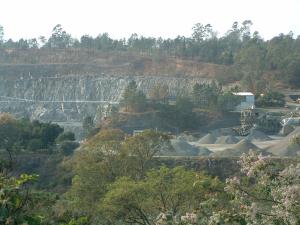
Dolerite Quarry
|
SteelSteel used in the building, construction and mining
sectors accounts for about 25% of local consumption. It is
comprised primarily of prefabricated profiles and sections
used in industrial building systems, civil structures
and concrete reinforcing bar. Global carbon steel
consumption reached a milestone of over one billion tons
in 2005, driven by extraordinary growth, primarily in
China. South Africa accounts for about 0,5% of global
steel consumption. Both globally and locally the steel
market is subject to business cycles linked to economic
growth patterns and steel price trends.
Per capita steel consumption in South Africa is roughly
half the world average (90 kg vs 170 kg). South African
per
capita consumption is similar to countries
such as Brazil (100 kg) and Egypt (75 kg), and
substantially above India (30 kg). Consumption of primary
carbon steel products has been fluctuating at levels of
between 4 - 4,5 million tons annually. In 2006/2007 the
port of Richards Bay exported 298,456 tons of steel, and
Durban 1,287,356 tons.
Local sales of primary carbon steel products in South
Africa in 2006 was an estimated 5,3 million tons. The
range of primary carbon steel products and semi-finished
products manufactured in South Africa includes: billets;
blooms; slabs; forgings; light, medium and heavy sections
and bars; reinforcing bar; railway track material; wire
rod; seamless tubes; plates; hot- and cold-rolled coils
and sheets; electrolytic galvanised coils and sheets;
tinplate; and pre-painted coils and sheets. BricksThe combined annual manufacturing capacity of the SA clay
brick industry is estimated to be in excess of 3,5 billion
bricks. It is estimated that 75% of all bricks used for
buildings are genuine clay bricks.
Bricks are made in a number of different places in KZN
including Durban, Pietermaritzburg, Newcastle and
Empangeni-Richards Bay. PaintsThere are several large paint factories in the Durban
area,
supplying more than 50,000 tons of products per annum by
road to the building trade all over South Africa. Inputs
include titanium, resins, solvents and other pigments. Building MaterialsThere are numbers of firms supplying building materials in
KZN that are branches of manufacturers in Gauteng, and
receive all their products for local distribution on
road .These include pipes, roofing, guttering, beams,
ceiling board, fascia boards, roof tiles, doors, windows,
panelling, plastic pipe, brass plumbing fittings and glass. Transport of Building ProductsThe vehicle configuration used for the transportation of
various building supplies ranges from rigids (8 ton) to
articulated combinations, some with draw-bar trailers and
interlinks. The vehicle type and size vary with the
commodity and the distance that it is to be transported,
as well as the method of load handling and the access to
the load and unload points.
The vehicle types used for building and construction
materials range from ready-mixed concrete mixers to
flatdecks, flatdecks with dropsides, tippers, etc.
For bricks the trend has been towards palletised and
shrink-
wrapped modular loads that can be loaded and unloaded by
on-board crane.
The bulk of the finished cement products is distributed
through the retail trade (resellers), and is ultimately
used by small to medium-sized builders, emerging
contractors and DIY users.
|
 |
